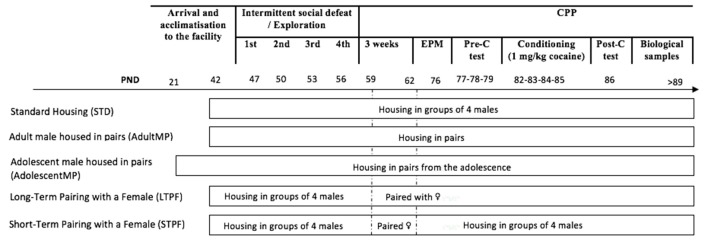Figure 1.
Experimental design. The experimental mice were divided into five different groups according to housing conditions. Animals in the Standard Housing group were housed in groups of four male mice per cage during the whole experiment (STD-nonISD n = 12 and STD-ISD n = 12). A second group of animals (AdultMP) were housed in pairs upon arrival at the animal facility on PND 42 (AdultMP-nonISD n = 12 and AdultMP-ISD n = 12). Similarly, a third group of adolescent mice (AdolescentMP) was housed in pairs on their arrival at the laboratory on PND 21 (AdolescentMP-nonISD n = 12 and AdolescentMP-ISD n = 12). Animals in the Long-Term Pairing with a Female (LTPF) housing condition were initially housed in the same way as those in the STD group, until the end of ISD protocol. Subsequently, 48 h after the last episode of social defeat, they were rehoused in a new cage with a female until the end of the experiments (LTPF-nonISD n = 12 and LTPF-ISD n = 12). Likewise, animals in the Short-Term Pairing with a Female (STPF) housing condition underwent the same housing procedure as LTPF animals, only that they were housed with the female for 72 h, after which, the experimental animals were returned to the original cage and regrouped as animals in standard housing groups (STPF-nonISD n = 8 and STPF-ISD n = 12).

